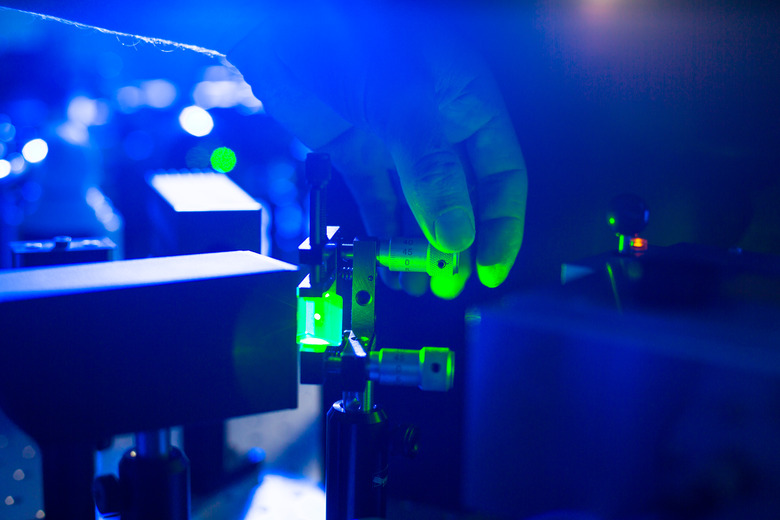How To Calculate A Balmer Series Wavelength
The Balmer series in a hydrogen atom relates the possible electron transitions down to the n = 2 position to the wavelength of the emission that scientists observe. In quantum physics, when electrons transition between different energy levels around the atom (described by the principal quantum number, n) they either release or absorb a photon. The Balmer series describes the transitions from higher energy levels to the second energy level and the wavelengths of the emitted photons. You can calculate this using the Rydberg formula.
The Rydberg Formula and Balmer’s Formula
The
Rydberg Formula and Balmer's Formula
The Rydberg formula relates the wavelength of the observed emissions to the principle quantum numbers involved in the transition:
\(\frac{1}{\lambda}=R_H(\frac{1}{n_1^2}-\frac{1}{n_2^2})\)
The λ symbol represents the wavelength, and _RH_ is the Rydberg constant for hydrogen, with _RH_ = 1.0968 × 107 m−1. You can use this formula for any transitions, not just the ones involving the second energy level.
The Balmer series just sets n1 = 2, which means the value of the principal quantum number (n) is two for the transitions being considered. Balmer's formula can therefore be written:
\(\frac{1}{\lambda}=R_H(\frac{1}{2^2}-\frac{1}{n_2^2})\)
Calculating
a Balmer Series Wavelength
1. Find the Principle Quantum Number for the Transition
The first step in the calculation is to find the principle quantum number for the transition you're considering. This simply means putting a numerical value on the "energy level" you're considering. So the third energy level has n = 3, the fourth has n = 4 and so on. These go in the spot for n2 in the equations above.
2. Calculate the Term in Brackets
Start by calculating the part of the equation in brackets:
\(\frac{1}{2^2}-\frac{1}{n_2^2}\)
All you need is the value for n2 you found in the previous section. For n2 = 4, you get:
\(\frac{1}{2^2}-\frac{1}{n_2^2}=\frac{1}{2^2}-\frac{1}{4^2}=\frac{1}{42}-\frac{1}{16}=\frac{3}{16}\)
3. Multiply by the Rydberg Constant
Multiply the result from the previous section by the Rydberg constant, _RH_ = 1.0968 × 107 m−1, to find a value for 1/λ. The formula and the example calculation gives:
\(\frac{1}{\lambda}=R_H(\frac{1}{2^2}-\frac{1}{n_2^2})=1.0968\times 10^7 \times \frac{3}{16}=2056500\text{ m}^{-1}\)
4. Find the Wavelength
Find the wavelength for the transition by dividing 1 by the result from the previous section. Because the Rydberg formula gives the reciprocal wavelength, you need to take the reciprocal of the result to find the wavelength.
So, continuing the example:
\(\lambda = \frac{1}{2056500}=4.86\times 10^{-7}\text{ m} = 486\text{ nanometers}\)
This matches the established wavelength emitted in this transition based on experiments.
Cite This Article
MLA
Johnson, Lee. "How To Calculate A Balmer Series Wavelength" sciencing.com, https://www.sciencing.com/calculate-balmer-series-wavelength-2647/. 13 December 2020.
APA
Johnson, Lee. (2020, December 13). How To Calculate A Balmer Series Wavelength. sciencing.com. Retrieved from https://www.sciencing.com/calculate-balmer-series-wavelength-2647/
Chicago
Johnson, Lee. How To Calculate A Balmer Series Wavelength last modified March 24, 2022. https://www.sciencing.com/calculate-balmer-series-wavelength-2647/
